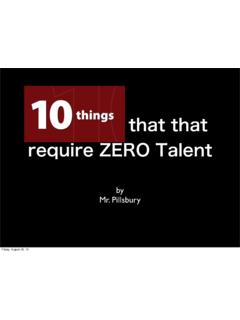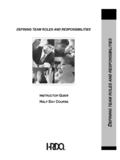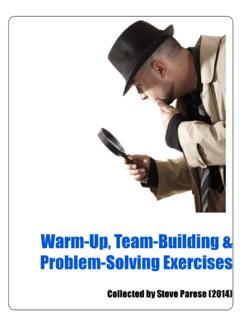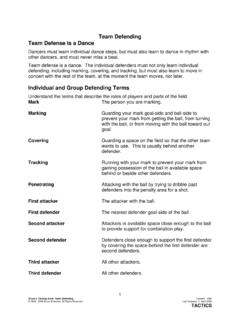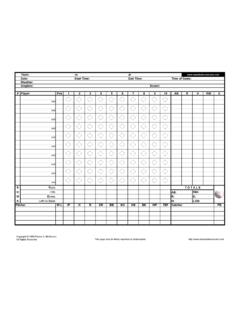Transcription of Overcoming the 5 Dysfunctions of a TEAM using …
1 Burlington VermontOvercoming the 5 Dysfunctions of a team using Adventure Play Presenter: Mike Anderson or 914-393-9140 Session Description: The true measure of a team is that it accomplishes what it sets out to achieve. Building an effective, cohesive team can be extremely hard to do because of the many personalities involved, varying interpretations of what success is and are people really doing what they are supposed to be doing. With determination and a plan it can be simple and uncomplicated. After a quick overview of the 5 Dysfunctions of a team model, we will investigate how teams can overcome these Dysfunctions utilizing common adventure play exercises. Be prepared for an interactive workshop and a willingness to share examples from your experience. Who is this Mike Anderson guy anyway: Mike Anderson first walked on the adventure play scene about 13 years ago. During that time he has worked as a rock climbing guide, a ropes course builder, trainer and manager and assisted numerous programs across the country and internationally.
2 All of this experience has allowed him to hone his skills and develop his own style and areas of interest among adventure professionals. Since then Mike has worked extensively in all areas related to adventure play, community building and team development. Mike holds an undergraduate degree in Recreation Administration and a Masters in Education. Mike had authored The INTERACT Curriculum, Teambuilding Puzzles and is working on a book project that blends conflict resolution, bully prevention and positive discipline (late 2007). Mike is also a contributor to numerous other texts on adventure play including the Book on Raccoon Circles I and II, Playing With a Full Deck, The More the Merrier, A Teachable Moment as well as two science based texts. Some of Mike s specialty areas include insight building, games and initiatives training and conflict resolution programming. Mike has presented workshops on these topics and many others all across the USA, and internationally and has delivered pre-conference and session workshops at many of the adventure and challenge industry s largest conferences.
3 A typical year has Mike traveling over 50,000 miles by air to over a dozen conferences and delivering over 80 days of custom programming all over the world. Mike has delivered programs on two continents, in 4 countries, and 29 states. Mike is the creator of many classic teambuilding exercises including the Table Web, Adventure Puzzle, Image Chips, the raccoon activities Believe it or Knot and Cutting the Cake, Decomposition Line, as well as Phobia and the Web We Weave. Mike is also responsible for the adaptation of Cup Stacking to a teambuilding activity. Mike is the owner of and lead trainer for Petra Cliffs, a Vermont based company and senior trainer for Challenge Works, Inc, a California based (Level 3 PVM) ropes course construction company. To obtain any of Mikes activities or texts please visit the following websites: Petra Cliffs (802) 657-3872 Challenge Works (831) 440-1421 Workshop Agenda Introduction What are the 5 Dysfunctions of a team ?
4 Activities for Overcoming the 5 Dysfunctions of a team ? Overcoming the 5 Dysfunctions - why these activities will help. Closing Activity Copyright Mike Anderson 2007 Burlington Vermont The 5 Dysfunctions of a team model (Taken directly from Patrick Lencioni s New York Times best-Seller, The Five Dysfunctions of a team ) **This book can be found in the Business/Management section at most bookstores ISBN# 0-7879-6075-6 and is also available online at Patrick Lencioni s website, ** Fear of CONFLICT Teams that lake trust are incapable of engaging in unfiltered and passionate debate of ideas (conflict). Instead they resort to veiled discussions and guarded comments. Lack of COMMITMENT Without having aired their opinions in the course of passionate and open debate, team members rarely, if ever, buy in an commit to decisions, though they may feign agreement during meetings. Avoidance of ACCOUNTABILITY Without committing to a clear plan of often hesitate to call their peers on actions and behaviors that seem counterproductive to the good of the team .
5 Inattention to RESULTS occurs when team members put their individual needs (ego, career development, recognition) or even the needs of the division ahead of the collective goals of the team . Absence of TRUST team members who are not genuinely open with one another about their mistakes and weaknesses make it impossible to build a foundation of trust. Copyright Mike Anderson 2007 Burlington Vermont dysfunction #1, the ABSENSE OF TRUST: The activities selected focus on community building and getting to know each other in a creative environment. Essentially we are working on the ground floor of a structure that is designed to create an environment where team members are willing to be vulnerable and participate in open and honest communication. It has often been said that we can learn more about someone in an hour of play that we can in a years worth of work and I strongly believe that to be true. Simply getting to know one another will not propel you beyond this dysfunction it will however put you on the right track.
6 As with every other process in our lives we must start our journey with s single step. That step is getting to know your colleagues, your office mates, your staff, your support team , your clients and yourself. Chris Cavert has spent the last decade telling people the more I know about you the less likely I am to hurt you which has become the basis for at least two books that I know of (one of them being a project of mine) and to me, what he means by that is, by simply taking time to learn a bit about those whom we spend the most time with we can being to develop a sense of trust amongst one another. I m not suggesting we actually throw ourselves under the bus for our office mates but when we trust our colleagues we can better share what is bothering us. By doing this we become less likely to say something that is hurtful or insensitive because we have a better understanding of who these people are; we have spent time generating commonalities and finding things we have in common.
7 Being able to talk openly and freely knowing that you are not intentionally offending the person or people you are talking to (to me) is the biggest piece to Overcoming dysfunction #1. dysfunction #1 - Activities for Overcoming the Absence of Trust As If (learned from Chris Cavert s activity files) Begin this activity by letting everyone know that you plan to give them a relationship to use for the upcoming interaction. Ask your group to greet another person in the room AS IF you are long lost friends , college roommates , interviewing for a job , someone you are intimidated by , a famous musician , favorite actor or actress , do not speak English . You can come up with as many different AS IF s as you wish. This is a great follow up activity to Handshakes. Sharing Connections (Teambuilding Puzzles) With the group seated in a circle, one person (who happens to be holding a ball of yarn) begins by mentioning various things they enjoy. For example, they might offer, I like to ride my mountain bike.
8 I enjoy cooking. I like to read. When one of these statements rings true for another participant in the group, they hold up both hands, and the person holding the ball of yarn rolls this ball over to them while keeping hold of the very end of the yarn. The second person (now holding the ball of yarn) begins sharing some of the activities they enjoy until another participant holds up their hands. And so the ball is passed around the group with each participant becoming connected to the other members of their group by the things they have in common. In most cases, group members only catch and roll the ball once. Each person catching the ball holds onto the string as the ball continues along its path to every other member of the group. After everyone has caught the ball, the final person must keep sharing information until the starting participant can agree with one of his or her comments. At this point, you can reverse the process by discussing personal goals for the day, challenges you are looking forward to, resources needed or other suitable topics.
9 The ball is passed from person to person along the string connecting them. Each person, when they receive the ball, carefully winds the yarn back into place before passing the ball on to the next person in the connection line. Tiny Teach (Karl Rhonke) everyone has a thing they can do, and do well. Maybe you have a trick that people find unique, a skill you consider valuable, perhaps you speak another language, or maybe you do something that is just not normal. This is your chance to shine, your chance to share. With a partner, take five minutes and teach one another one thing you find fun and interesting. We will share a few of our skills at the end. Mike can be reached by phone at 914-393-9140 or 802-657-3872 or via at And don t forget to check out our website for upcoming workshops and free, downloadable activity documents. Sign up for our free Pod-cast at games added bi-weekly. Copyright Mike Anderson 2007 Burlington VermontDysfunction #2, the FEAR OF CONFLICT: According Lencioni the failure to build trust is damaging because it sets the tone for [the second dysfunction ] the fear of conflict (page 118).
10 By creating an environment where people feel they can participate in open and honest communication we by default create an environment where unfiltered and passionate discussion can take place. Perhaps the biggest contributor to the Fear of Conflict is our innate desire to assume. In January I had the opportunity to meet Geoff Cox from RSVP Design (the creator of the communication activity Colourblind ), anyway during his workshop he continually encouraged us to pay special attention to our assumptions of the activity, of our group mates and our goal. The list that we were able to create in a few minutes based on our attitudes toward the activity, the other participants, the purpose, the potential value, etc astonished me. We found ourselves moving from an attitude of we can do this to do you suppose were even supposed to try to solve the problem? Unasked and even more importantly, unanswered questions create culture of distrust and as Lencioni indicates numerous time in his book, distrust discourages conflict.
